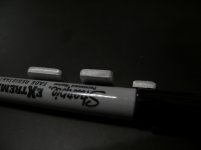We're currently putting holes in .125" 6061-T6 aluminum standard unipunches, but now we want to improve the process.
I'm speccing out some punches and dies, and most of the information I'm finding on punch clearance for aluminum is saying 7.5% per side, although the old die design reference books suggest smaller clearances. For .125" thick material, this is roughly .009" per side
I have two punches/dies I'm speccing:
1:
punch: .354" square with .015 radius
die: .373" square with .024 radius
2:
punch: .625" x .500" with .059" radius
die: .644" x .519" with .069 radius*
Does this sound correct?
Thanks,
Daniel
I'm speccing out some punches and dies, and most of the information I'm finding on punch clearance for aluminum is saying 7.5% per side, although the old die design reference books suggest smaller clearances. For .125" thick material, this is roughly .009" per side
I have two punches/dies I'm speccing:
1:
punch: .354" square with .015 radius
die: .373" square with .024 radius
2:
punch: .625" x .500" with .059" radius
die: .644" x .519" with .069 radius*
Does this sound correct?
Thanks,
Daniel




